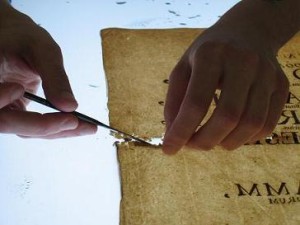You can get all the materials and all the instructions you need to repair a book online. Some experts will recommend cleaning the book with a swab and dishwashing detergent. Others are bit on the fence about acid-free tape, because it’s just a book after all. It’ll be read. It’ll fall apart again. It’ll go in the free box during the next yard sale. It’s just a book.
Wrong! If you’re a collector, it’s never just a book. It’s a piece of history. When considering book preservation efforts, don’t get lead astray by experts on book repair. They know what they’re talking about, but first ask yourself whether or not you’re getting your information from the right source. Nine times out of ten, a librarian will be providing the information. Their motivations differ from the collectors, but they repair the majority of the books. So, they provide the majority of the information available on taping up, strengthening the spine, recovering and even rebinding their old books. It cannot be overstated enough that their methods generally devalue rare books.

Ignore the librarians. They need their books to keep circulating. Library books have already been processed with cellophane, tape, stamps, ink, hole punches, adhesives, labels, and other markings that make it useful to a library. Even in an academic, private, or government library, the book is not treated and protected as an artifact. If it’s in a library, it’s preserved so that the information it contains can be accessed. This is simply not true for a book in a collection. The moment the book transcends the role of providing information and becomes an artifact; the way the book is preserved must change, too.
The world of book collecting has wavered in its opinion on how much repair is necessary or desired, but the general trend, the maxim to live by when it comes to altering a rare book’s integrity is that less is more.
The consequences of not following this maxim can be tragic. I once worked in a Jewish community library in New Zealand and saw first hand the devastation generated by over zealous librarians. The earliest settlers to the islands brought copies of the Talmud that were about 370 years old. Each page had foxing, a type of mold, growing on it. The binding had decayed. The manuscripts could not be read easily, but they were rare and beautiful. Each one had value as a historic artifact despite the fact that the information they contained was no different than the ten other copies pressed haphazardly on the shelves next to them. These large, heavily bound, manuscripts had survived generations and touched many hands.
It’s really a shame that after all those centuries someone in the 1970s decided they should be used and in order to do so – rebinding was in order. I know what some might be thinking, that there comes a time and place where a book serves no function, and even collectors can and should perform moderate book preservation. The useless book may be bound with string and hidden in an archival box and serve no purpose. Not all books ought to suffer this fate. I agree. There comes a time for book preservation. However, there is never a time when someone should rebind a book with wallpaper. And if one is forced at gunpoint to rebind a book and recover it with wallpaper, one should choose death rather than silvery floral wallpaper. Seventh century printing does not go well with hippie-style free love daises. It must have seemed like a good idea at the time, but the damage cannot be undone.
I will never get over this. I’ve been told it was a common occurrence in Oceania a few decades ago and that loads of books were recovered this way. How was the person who pasted the paisleys to know that they would be tacky eyesores in a few years? We don’t know for certain – I suppose, but we can minimize these tragedies by always doing the least amount of book repair possible.
Preserve don’t repair and everything will be groovy.
